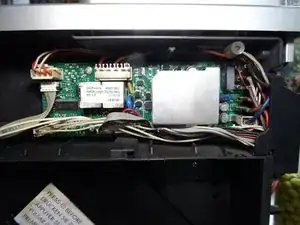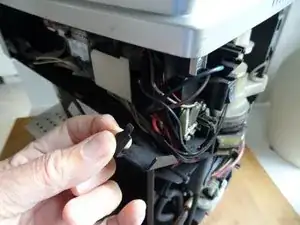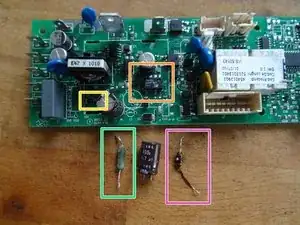Inleiding
Let op: verwijder altijd eerst de stekker uit het stopcontact voordat je gaat demonteren.
Als de machine niet meer kan worden ingeschakeld, kan de voedingskaart defect zijn. In de meeste gevallen zijn de componenten van de schakelende voeding doorgebrand. De onderdelen zijn niet duur en het is de moeite waard om te proberen ze te repareren. Je moet echter wel goed kunnen solderen/desolderen, we hebben a guide.
De onderdelen zijn vrij eenvoudig te vinden in elektronicawinkels, in het bijzonder heb je een weerstand van 47 Ohm, 3W, een spoel van 1mH en een IC LNK364GN nodig.
Gereedschap
-
-
Verwijder alle losse delen zoals het waterreservoir, de opvangbak en de zetgroep.
-
Draai de machine zo dat de achterkant naar je toe wijst.
-
Verwijder de vijf T20 Torx Security-schroeven.
-
-
-
Til het achterste paneel van het koffiezetapparaat af.
-
De volgende onderdelen zijn meteen zichtbaar:
-
Koffiemolen
-
De pomp
-
De stromingsmeter
-
-
-
Verwijder de achterzijde van het toestel: schuif het deksel aan de kant van het waterreservoir een klein stukje naar achteren en verwijder het.
-
-
-
Het voedingsbord bevindt zich achter het deksel. Het bord is bevestigd door middel van vier schroeven in de hoeken en verbonden met een aantal kabels.
-
Duw de kabels een beetje opzij en draai de vier kruiskopschroeven los.
-
-
-
De kabels hebben veel verschillende connectoren en zijn bijna onmogelijk door elkaar te halen. Let vooral goed op waar de kabelschoenstekkers zijn aangesloten, en neem eventueel foto's van alle stekkers en aansluitingen.
-
De platte kabelschoenstekkers kunnen gemakkelijker worden verwijderd als je het zwarte klepje rechts in de hoek van het apparaat wat naar de zijkant tilt.
-
Til het voedingsbord er een paar centimeter uit.
-
Maak alle verbindingen voorzichtig los. Sommige zijn extra bevestigd met vergrendelingen die je eerst moet wegduwen of indrukken.
-
-
-
Hier is de voedingskaart. De aluminium koelplaat zit alleen met drie lipjes vast aan de achterkant van het bord. Gebruik een tang om de drie lipjes recht te maken en til de koelplaat eruit. Denk eraan dat een triac vastgeklemd zit aan de koelplaat.
-
-
-
Dit zijn de belangrijkste onderdelen:
-
R55: Weerstand, 47 Ohm, 3 W
-
L1: inductie 1mH
-
U1: geïntegreerde schakelaar IC LNK364GN
-
-
-
Desoldeer eerst deze drie onderdelen. Gebruik een desoldeerpomp en/of desoldeervlecht. Het desolderen van het IC is lastig omdat het een SMD-versie is. Het is makkelijker als je vooraf ook de condensator C3 desoldeert; je kunt eventueel ook voorzichtig de pennen van het IC afknippen.
-
Controleer de componenten:
-
De inductie L1 van deze printplaat was duidelijk defect, hij was zwart, gele kralen waren uitgezweet, de weerstand was veel te hoog, hij zou rond de 3 Ohm moeten liggen.
-
De 47 Ohm weerstand R55 was oneindig - dus niets kan meer werken.
-
Het IC LNK364 was waarschijnlijk de oorzaak van het defect, tussen de twee pinnen met de grote opening zou de weerstand een paar megOhm moeten zijn, het was slechts een paar Ohm.
-
Controleer voor de zekerheid ook diode D1 (indien geïnstalleerd); deze mag maar in één richting geleiden. Als hij defect is, vervang hem dan door een 1N4005. (kathode, d.w.z. min in richting L1)
-
Soldeer alles weer vast en neem eerst een kop koffie... andere componenten kunnen ook defect zijn...
-
Voer de stappen in omgekeerde volgorde uit om het apparaat weer in elkaar te zetten.
21 commentaren
Hallo die Anleitung, passt im wesentlich auch zur ECAM 23 450S - die Platine sieht etwas anders aus - man muss kein Kühlblech demontieren, die Bauteile tragen die gleichen Nummern / Bezeichnungen. Nach dem Wechsel läuft unsere Minna wieder. Danke - auf die nächsten 12 Jahre.
A. Weber -
Freut mich, Grüße.
VauWeh -
Hallo,
ESAM 3600, die Platine ist auch anders die baustein Bezeichnung ist gleich.
Reparatur hat dank Anleitung bestens geklappt.
Danke
LG Dieter
Interessante Info, danke. Freut mich, dass es geklappt hat.
VauWeh -
Thank you for sharing! Had the same problem with mine, thanks to your guide I could repair the board and the machine works well as before. Nice!
Robert
I'm glad to hear that. Another machine saved. Repair is war on entropy!
VauWeh -












Screwdriver must have a hole? What does that mean? Is it a standard Tx20 bit?
Kevin -
No, it is a TR20 Security Bit, which really has a hole (if you look to the star shape) . See TR10 Torx Security Screwdriver
VauWeh -
Bits from iFixit are equipped with it.
VauWeh -